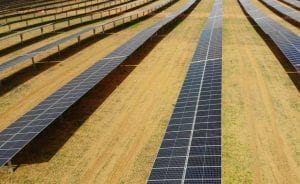The controversial Technology Roadmap unveiled by the Morrison government this week could force the country’s green bank to sell profitable investments in wind and solar projects so it can channel these funds into new preferred technologies such as carbon capture and storage.
The Morrison government has promoted the Technology Roadmap by citing two key figures that it promises to deliver, a 250 million tonne reduction in annual emissions by 2040, and $18 billion in government investment in new ‘low emissions’ technologies by 2030.
These are substantial numbers if credible – but there has been little offered to explain how those figures have been derived. It is likely that the funding envelope can only be met by recycling Gillard era investments, and could require the Clean Energy Finance Corporation to sell some $8 billion in assets.
An explanation of the 250 million tonnes of emissions reductions each year by 2040 has not been offered, other than a short line in the Technology Roadmap report that states it would be achieved “through deployment of priority technologies at home and Australia’s low emissions exports”.
This suggests the figure could be based on emissions reductions achieved through the export of fuels like hydrogen, or even fossil gas, as Taylor has previously claimed when attempting to explain Australia’s surging greenhouse gas emissions caused by the gas sector.
A little more detail was provided in an explanation for the $18 billion investment figure, which was included in a footnote to the First Low Emissions Technology Statement under the Technology Roadmap which was launched on Tuesday by federal energy and emissions reduction minister Angus Taylor.

Taylor played up the $18 billion investment figure in an address to the National Press Club in Canberra, saying that the investments would underpin private sector investment in new ‘low emissions’ projects.
“The Roadmap will guide the deployment of the $18 billion that will be invested by the Federal Government, including through the CEFC, ARENA, the Climate Solutions Fund and the Clean Energy Regulator,” Taylor told the Press Club.
“Our plan is to increase that to at least $50 billion through the private sector, state governments, research institutions and other publicly funded research agencies.”
However, the explanation makes clear that very little of the expected $18 billion in low emissions investment that the Morrison government promises over the next ten years is new money, and it will be heavily reliant on policies established under previous Labor governments – and opposed by the Coalition – to deliver investment.
The bulk of the $18 billion figure consists of investments being made by the Clean Energy Finance Corporation (CEFC), an agency established under the Gillard government in 2012, which is expected by the Technology Roadmap to make $13 billion in investments between now and 2030.
According to the agency’s last annual report, the CEFC currently maintains an investment portfolio that includes $1.1 billion worth of investments in solar projects, $740 million in wind energy projects, $494 million in energy efficiency projects, as well as $512 million in Australian green bonds.
These investments have proven profitable, with the agency delivering an average 5.29 per cent annual investment return since its inception.
According to the Technology Roadmap, the Morrison government has assumed that the CEFC will continue making new investments at current rates, an average of $1.3 billion each year for the next ten years.
What is unclear is how the CEFC can continue to make future investments at that rate, given the agency was originally allocated just $10 billion in funds to invest in the clean energy sector, and the Morrison government agreeing to provide the CEFC with an additional $1 billion under the Grid Reliability Fund.
According to a recent investment updated released by the CEFC, more than $6 billion of the original funding allocated to the CEFC is already tied up in investments.
This leaves less than $5 billion in unallocated funds available to the CEFC (assuming the $1 billion Grid Reliability Fund passes parliament), and suggests that to meet the Morrison government’s expected $13 billion of new CEFC funds by 2030, the agency will have to sell down some of its existing investments to be able to redeploy already committed funds into new projects.
To meet the $18 billion target, the government will likely have to compel the CEFC to offload some, if not all, of its profitable investments in wind, solar, green buildings and green bonds to reinvest the money in projects that could include gas projects or carbon capture and storage.
At least $8 billion in investments will need to be sold-off and and the funds recycled into new projects under the government’s new investment criteria if the CEFC is to maintain its $1.3 billion a year of new investment.
The move to repurpose funding that had been dedicated to supporting Australia’s emerging clean energy sector was criticised by Climate Council member, and former chair of the Australian Renewable Energy Agency (ARENA), Greg Bourne.
“The Government’s move to change the remit of both the CEFC and ARENA shows how desperate it is to support the fossil fuel industry,” Bourne said.
” Rather than focussing on past technologies, the Government should be driving for a cleaner future. Only a renewables-led future makes economic sense. Propping up failing fossil fuels and commercially non-viable technologies like CCS is a waste of taxpayers’ money.”








